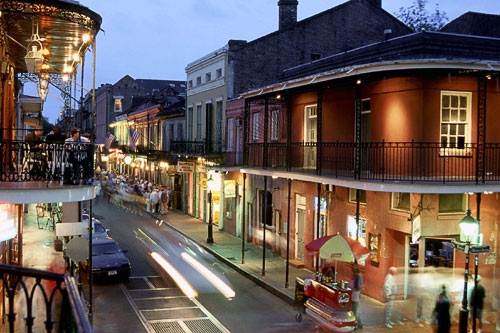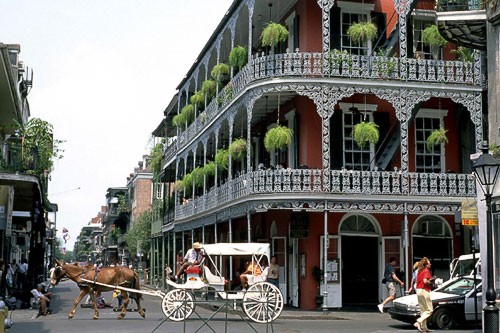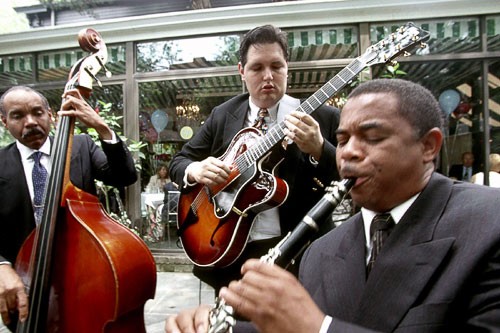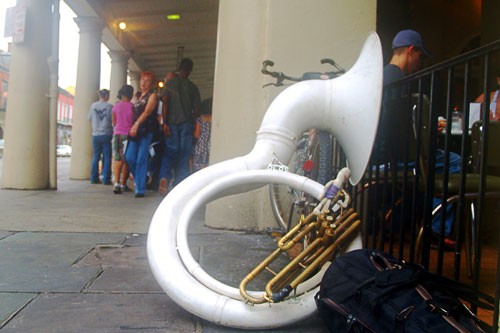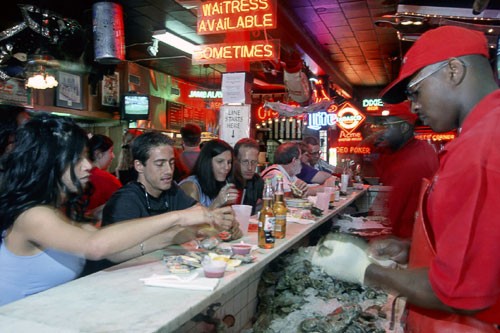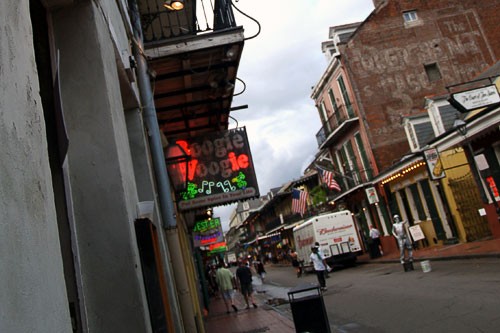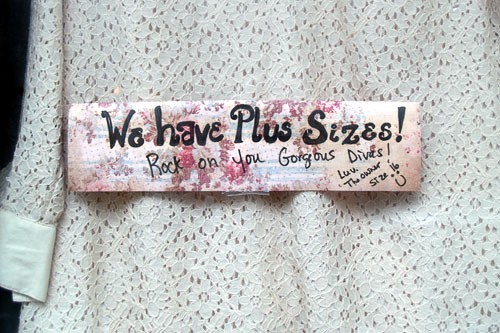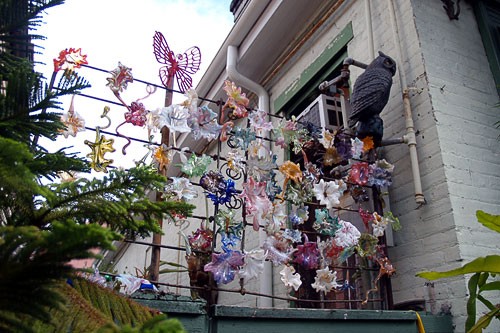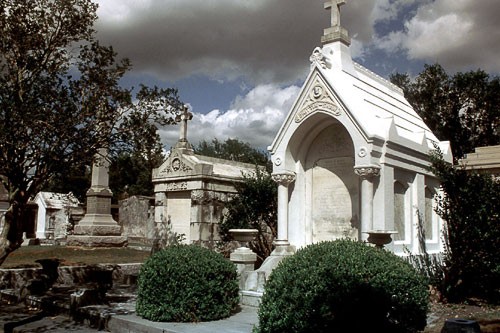New Orleans After Katrina: The Best Things Never Change
By
Five Years After Katrina
By Matt Hannafin
The fifth anniversary of Hurricane Katrina gave American news shows a good excuse to rerun their old storm footage. Nothing makes great television like disaster and suffering, but the dichotomy between the images on my TV and the sights out my New Orleans hotel window was a little too stark. Fact is, in much of New Orleans you'd be hard pressed to find any hint that the city was Waterworld just a few years ago. Yes, reconstruction continues in the hard-hit Lower Ninth Ward and other areas. And yes, we must remember that the storm, its aftermath, and the bungled government response killed some 1,500 people and displaced nearly 400,000 more, most temporarily but some permanently. But, as I heard repeatedly during my visit, Katrina is the past. Unlike some other historic cities, where yesterday's big events are frozen in amber or kept alive through historic re-enactment, New Orleans has always given a very particular impression of timelessness -- the sense that the 18th and 19th centuries are still very much alive here, dressed up like Keith Richards and having a grand old time with their young, 21st-century girlfriends. With attitude like that, who has time to look back?
So here's to timelessness, and to the timeless jewels, warts, and oddments that make New Orleans New Orleans. In it's time, the city's seen fire, fever, and flood, yet its citizens call it "The Big Easy." That tell you something?
Photo Caption: Bourbon Street at night in New Orleans. Photo by Richard Nowitz
The fifth anniversary of Hurricane Katrina gave American news shows a good excuse to rerun their old storm footage. Nothing makes great television like disaster and suffering, but the dichotomy between the images on my TV and the sights out my New Orleans hotel window was a little too stark. Fact is, in much of New Orleans you'd be hard pressed to find any hint that the city was Waterworld just a few years ago. Yes, reconstruction continues in the hard-hit Lower Ninth Ward and other areas. And yes, we must remember that the storm, its aftermath, and the bungled government response killed some 1,500 people and displaced nearly 400,000 more, most temporarily but some permanently. But, as I heard repeatedly during my visit, Katrina is the past. Unlike some other historic cities, where yesterday's big events are frozen in amber or kept alive through historic re-enactment, New Orleans has always given a very particular impression of timelessness -- the sense that the 18th and 19th centuries are still very much alive here, dressed up like Keith Richards and having a grand old time with their young, 21st-century girlfriends. With attitude like that, who has time to look back?
So here's to timelessness, and to the timeless jewels, warts, and oddments that make New Orleans New Orleans. In it's time, the city's seen fire, fever, and flood, yet its citizens call it "The Big Easy." That tell you something?
Photo Caption: Bourbon Street at night in New Orleans. Photo by Richard Nowitz
Romantic & Evocative Architecture
Probably the most visually distinctive city in the United States, New Orleans piles style on style, with 18th- and 19th-century townhouses, Creole cottages, Victorian fantasies, Greek Revival homes, French Colonial villas, and all manner of 20th and 21st century styles mixing it up within just a few square miles. The historic French Quarter, which saw little or no damage from Katrina, is now and forever known for its wrought-iron balconies, which adorn hundreds of late 18th- and early 19th-century buildings throughout the 85-square-block district. Then as now, they offer the possibility of a cooling breeze during New Orleans' notoriously sticky summers.
Photo Caption: French Quarter street scene in New Orleans. Photo by Richard Nowitz
Photo Caption: French Quarter street scene in New Orleans. Photo by Richard Nowitz
Music on Every Corner ...
The cradle in which the first jazz swung, New Orleans is probably the most musical city on the planet. Walk through the French Quarter any evening and you'll hear brass bands performing on street corners, small jazz groups huddled under balconies, soloists staking out corners, jazz and R&B acts big and small performing at countless clubs, and blaring rock bands pounding away in Bourbon Street's booze halls. Festival time only amplifies the already heady mix, with Mardi Gras bringing out the marching bands and early spring's JazzFest featuring scores of local and international artists performing not only jazz but blues, R&B, gospel, Cajun, zydeco, Latin, folk, rock, hip-hop, bluegrass, and everything in between.
Photo Caption: Commander's Palace jazz brunch in New Orleans.
Photo Caption: Commander's Palace jazz brunch in New Orleans.
... And Sousaphones, Too
New Orleans is probably the only city in the world where you can commonly see (or hear) a dozen sousaphones during the course of an average day. Nevertheless, it's a fact that Hurricane Katrina hit New Orleans' musicians hard. Speaking last week at a ceremony for the Louisiana State Museum's upcoming exhibit, "Living with Hurricanes: Katrina and Beyond," local R&B legend and Grammy-winner Irma Thomas noted that in the storm's aftermath, with performance opportunities few or nil, many local musicians struggled just to survive. In the years since, according to Thomas, the city has realized what it has: "They finally get it, how important the musicians are to this city, to this city's cultural life." That said, a new report by the nonprofit musicians-aid group Sweet Home New Orleans shows that earnings for the city's musicians are down about 43% from pre-storm levels. So if you visit, and you like what you hear, buy some CDs from the bands, OK?
Photo Caption: A sousaphone cadges for beignets outside Cafe du Monde in New Orleans.
Photo Caption: A sousaphone cadges for beignets outside Cafe du Monde in New Orleans.
Food Like You Won't Believe
Here's a remarkable fact: According to the New Orleans Convention & Visitors Bureau, there are now 300 more restaurants in New Orleans than there were before Hurricane Katrina. Three hundred! It just blows the mind, especially when you consider that even pre-Katrina you couldn't toss a stick here without hitting a legendary eatery, a gourmet newcomer, a down-home po' boy or fried chicken joint, and maybe a Lucky Dog cart or two.
What accounts for it all? Credit the city's longtime culinary reputation coupled with the incredible spirit of post-Katrina rebuilding. Chef Scott Boswell of French Quarter restaurants Stella! and Stanley was the first chef to resume serving food in the city post-Katrina, setting up a burger-and-beer operation for aid workers and media just days after the storm, and scrounging supplies and staff where he could find them. "I wouldn't want to do it again, but I wouldn't trade the experience for anything," he said when I spoke with him last week. "It was an incredible time." Emphasizing the spirit of togetherness and entrepreneurialism the storm and its aftermath engendered, he says the city is now "an open forum for success. I'm going to do as much here as I can."
Photo Caption: Oyster Shucker at Acme Oyster House in New Orleans. Photo by Richard Nowitz
What accounts for it all? Credit the city's longtime culinary reputation coupled with the incredible spirit of post-Katrina rebuilding. Chef Scott Boswell of French Quarter restaurants Stella! and Stanley was the first chef to resume serving food in the city post-Katrina, setting up a burger-and-beer operation for aid workers and media just days after the storm, and scrounging supplies and staff where he could find them. "I wouldn't want to do it again, but I wouldn't trade the experience for anything," he said when I spoke with him last week. "It was an incredible time." Emphasizing the spirit of togetherness and entrepreneurialism the storm and its aftermath engendered, he says the city is now "an open forum for success. I'm going to do as much here as I can."
Photo Caption: Oyster Shucker at Acme Oyster House in New Orleans. Photo by Richard Nowitz
Drink, Drink, and More Drink
For better or worse (and I'm really not sure which), New Orleans is big on drinking, and big on drinking big. While polite society downs it Sazeracs and mint juleps in gentlemanly quantities, the out-of-town werewolves that jam Bourbon Street 24-7 generally favor more heroic and foolhardy concoctions: rum Hurricanes in yard-long plastic glasses, sweet-crazy Hand Grenades ("New Orleans' Most Powerful Drink"®), and Bud Lites served in what look like half-gallon bottles. Many bars and clubs have walk-up windows, so you don't even have to step off the sidewalk for a refill. Nearby, on Canal Street, even the CVS and Walgreen's drug stores have full liquor departments.
Photo Caption: Bourbon Street in New Orleans.
Photo Caption: Bourbon Street in New Orleans.
An Appreciation of Size
The past decade's general supersizing trend in the U.S. has knocked New Orleans off its old-time throne as "The Fattest City in America" (the 2010 Men's Heath ranking has it way down in 18th place), but as a friend of mine who moved to NoLA from NYC noted, patting his new belly, "You can't be sexy in New Orleans unless you're fat." This is a city where nobody really seems to take the whole "watch what you eat" ethic to heart. Huge portions, creamy sauces, and gut-busting multi-course meals are standard fare, and woe to the vegetarian who wanders into a typical NoLA restaurant and expects to order off the menu.
Photo Caption: Shop window in New Orleans' French Quarter.
Photo Caption: Shop window in New Orleans' French Quarter.
Serendipity & Style
A city is a canvas on which we mark our originality, and New Orleans' people tend to use all the crayons in their box. In the French Quarter, many balconies are small jungles of hanging plants, dotted with evocative statuary. Look down an alley and you might spot an idyllic, hidden courtyard, all palms, ferns, fountains, and shady nooks. Windows might be little jewel-box museums of trinkets. At Mardi Gras, the people themselves become the canvas, decked out in elaborate costumes that might take an entire year to prepare.
Photo Caption: Decorated fence in New Orleans' French Quarter.
Photo Caption: Decorated fence in New Orleans' French Quarter.
Magnificent Decay
For me, an important part of New Orleans' physical beauty lies in its patchwork quality -- the way its three centuries of overlapping architecture are overlaid with three centuries of peoples' efforts to keep the whole thing from falling apart. As in cities like Amsterdam, gravity takes its toll: You'll be walking down a street, looking at the angle at which one of the old balconies has settled, and think, "Wow, I wouldn't sit out on that" -- and then you notice that people are, in little deck chairs, with drinks on a table between them. The city's climate also has an effect. As I heard some unnamed person say, "We didn't need no hurricane to be wet." New Orleans' frequent rains can be dramatically drenching, and humidity is a near constant presence. The way a stream can carve a canyon given enough time, New Orleans' sultry climate is gradually eating it alive, but I wouldn't worry too much. The Venice Lagoon has been working on its namesake city for about 1,500 years, and Venice, though sometimes soggy, is still standing.
Photo Caption: Teetering residential/commercial house in New Orleans' French Quarter.
Photo Caption: Teetering residential/commercial house in New Orleans' French Quarter.
Real Decay: New Orleans' Cemeteries
Spend much time in New Orleans and sooner or later you'll run across the dead. You almost can't avoid it, 'cause they're right up there in the open. Because the city has always been prone to flooding, bodies have been interred aboveground since its earliest days, sometimes in elaborate tombs that sit one beside the other, bleaching in the Southern sun -- little cities of the dead in a city of the living. St. Louis Cemetery No. 1, on Basin Street between Conti and St. Louis streets (at the top of the French Quarter), is the oldest and most iconic, with stones dating back to 1789. In the Garden District, Lafayette Cemetery No. 1, on Sixth St. right across from Commander
New Orleans Streetcars
"They told me to take a streetcar named Desire and then transfer to one called Cemetery and ride six blocks and get off at Elysian Fields," says Blanche DuBois in Tennessee Williams' A Streetcar Named Desire. The "Desire" line once ran through the French Quarter to its namesake street, but it's now no more -- one of more than 20 lines that were replaced by bus service in the 1940s, '50s, and '60s. Today the city has only three lines left. The St. Charles Avenue Line is the oldest continually operated street rail line in the world, running 13.2 miles from Canal Street in the Central Business District out through the Garden District to Carrollton. The Riverfront Line and the Canal Street Line are both relatively new routes created to revive the city's great streetcar tradition. The Riverfront service began in 1988, tracking the route of the Mississippi from Esplanade (the eastern edge of the French Quarter) to Julia Street (site of the Riverwalk mall and cruise ship terminal). The Canal Street Line is even newer, commencing operation in 2004 and running 5.5 miles from the French Market to City Park, the New Orleans Museum of Art, and several of the city's historic cemeteries.
Katrina did a number on all three lines. The Canal line resumed partial service after just three months, but it took until 2008 before service was fully up and running on the St. Charles line.
Photo Caption: A classic St. Charles streetcar, picking up at Canal Street in New Orleans.
Katrina did a number on all three lines. The Canal line resumed partial service after just three months, but it took until 2008 before service was fully up and running on the St. Charles line.
Photo Caption: A classic St. Charles streetcar, picking up at Canal Street in New Orleans.
The Mississippi
Flowing right at the eastern foot of the French Quarter, the Mississippi giveth and the Mississippi taketh away: The city grew here specifically because it's such a wonderful spot for river trade, and thriving port operations (the country's fifth biggest, by volume), along with associated shipbuilding, shipping, logistics, and other businesses, have been a primary engine of the city's economy. On the downside, every once in a while a storm surge will come up the river from the Gulf of Mexico and POW! Big disaster.
Post-Katrina, it took only about a week for the port to get some of its operations back up and running, and by 2006 it was back up to 86% of its pre-Katrina business, despite the destruction of one of its container shipping terminals. The port's cruise operations didn't return to strength until October 2006, when NCL's Norwegian Sun became the first large cruise ship to return to the city for regular runs. In 2011 and 2012, NCL, Carnival, and Royal Caribbean will all have megaships sailing from the port, some of them year-round.
Most profoundly affected by the storm were New Orleans historic riverboat cruises, particularly the marquee operation of Delta Queen Steamboat Company, which suffered such losses in the storm's wake that it never recovered. To this day, there are still no overnight cruises aboard classic paddlewheel riverboats on the Mississippi, though vessels like the Natchez and Creole Queen continue to do day and dinner cruises.
Photo Caption: The tugboat Louise and steamboat Natchez on the Mississippi. Photo by Richard Nowitz
Post-Katrina, it took only about a week for the port to get some of its operations back up and running, and by 2006 it was back up to 86% of its pre-Katrina business, despite the destruction of one of its container shipping terminals. The port's cruise operations didn't return to strength until October 2006, when NCL's Norwegian Sun became the first large cruise ship to return to the city for regular runs. In 2011 and 2012, NCL, Carnival, and Royal Caribbean will all have megaships sailing from the port, some of them year-round.
Most profoundly affected by the storm were New Orleans historic riverboat cruises, particularly the marquee operation of Delta Queen Steamboat Company, which suffered such losses in the storm's wake that it never recovered. To this day, there are still no overnight cruises aboard classic paddlewheel riverboats on the Mississippi, though vessels like the Natchez and Creole Queen continue to do day and dinner cruises.
Photo Caption: The tugboat Louise and steamboat Natchez on the Mississippi. Photo by Richard Nowitz
Survival Skills
Immediately post-Katrina, many people wondered if New Orleans would ever be able to get back on its feet. Some wondered if they should cancel Mardi Gras that year, questioning the appropriateness of having a big party after such a disaster -- but those naysayers were in the minority. As Frommer's late, great New Orleans writer Mary Herczog observed of the ensuing party, "The spirit was immeasurably high, as New Orleanians and lovers of the city alike turned out in their most glittery or satirical costumes, screaming for beads, engaging in other traditions, and generally exalting in a moment that not that long before seemed like it would never come again. They had survived, and they were filled with hope that their city would, too. That there has not been [a significant] focus on Katrina during subsequent Mardi Gras is a good sign; it means the city and its loyal residents are moving into the future that has brought along the best, not the worst, of the past."
With the New Orleans Saints reigning as Super Bowl Champions; with new hotels, restaurants, and nightlife springing up to serve business and leisure travelers; with new museums, including the expanded National World War II Museum and the Audubon Insectarium; and with more than three dozen major festivals dotting the city's calendar, who can deny that New Orleans, while still in recovery mode, is not only surviving, but doing it with style? Not me.
Photo Caption: Mardi Gras float and crowd in New Orleans. Photo by Romney Caruso
With the New Orleans Saints reigning as Super Bowl Champions; with new hotels, restaurants, and nightlife springing up to serve business and leisure travelers; with new museums, including the expanded National World War II Museum and the Audubon Insectarium; and with more than three dozen major festivals dotting the city's calendar, who can deny that New Orleans, while still in recovery mode, is not only surviving, but doing it with style? Not me.
Photo Caption: Mardi Gras float and crowd in New Orleans. Photo by Romney Caruso





